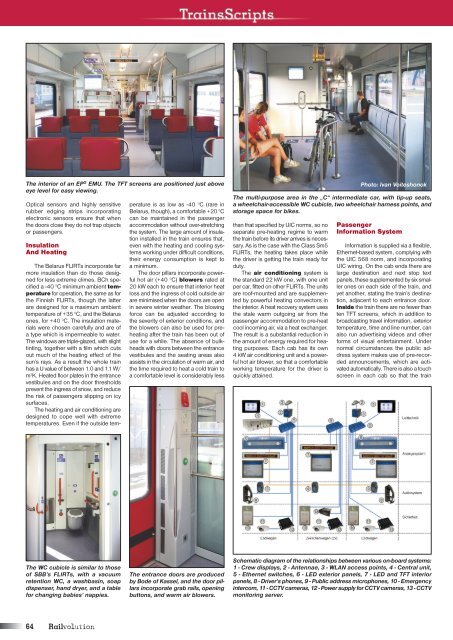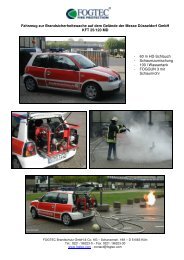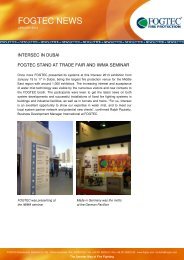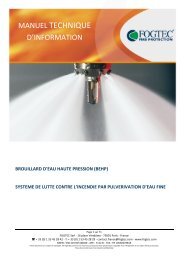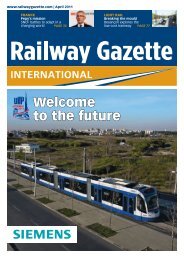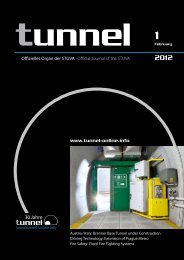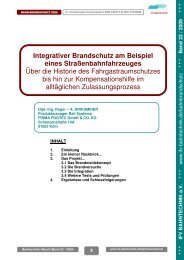You also want an ePaper? Increase the reach of your titles
YUMPU automatically turns print PDFs into web optimized ePapers that Google loves.
The interior of an EP G <strong>EMU</strong>. The TFT screens are positioned just above<br />
eye level for easy viewing.<br />
Optical sensors and highly sensitive<br />
rubber edging strips incorporating<br />
electronic sensors ensure that when<br />
the doors close they do not trap objects<br />
or passengers.<br />
Insulation<br />
And Heating<br />
The Belarus FLIRTs incorporate far<br />
more insulation than do those designed<br />
for less extreme climes. BCh specified<br />
a -40 0 C minimum ambient temperature<br />
for operation, the same as for<br />
the Finnish FLIRTs, though the latter<br />
are designed for a maximum ambient<br />
temperature of +35 0 C, and the Belarus<br />
ones, for +40 0 C. The insulation materials<br />
were chosen carefully and are of<br />
a type which is impermeable to water.<br />
The windows are triple-glazed, with slight<br />
tinting, together with a film which cuts<br />
out much of the heating effect of the<br />
sun’s rays. As a result the whole train<br />
has a U value of between 1.0 and 1.1 W/<br />
m 2 K. Heated floor plates in the entrance<br />
vestibules and on the door thresholds<br />
prevent the ingress of snow, and reduce<br />
the risk of passengers slipping on icy<br />
surfaces.<br />
The heating and air conditioning are<br />
designed to cope well with extreme<br />
temperatures. Even if the outside tem-<br />
perature is as low as -40 0 C (rare in<br />
Belarus, though), a comfortable +20 0 C<br />
can be maintained in the passenger<br />
accommodation without over-stretching<br />
the system. The large amount of insulation<br />
installed in the train ensures that,<br />
even with the heating and cooling systems<br />
working under difficult conditions,<br />
their energy consumption is kept to<br />
a minimum.<br />
The door pillars incorporate powerful<br />
hot air (+40 0 C) blowers rated at<br />
20 kW each to ensure that interior heat<br />
loss and the ingress of cold outside air<br />
are minimised when the doors are open<br />
in severe winter weather. The blowing<br />
force can be adjusted according to<br />
the severity of exterior conditions, and<br />
the blowers can also be used for preheating<br />
after the train has been out of<br />
use for a while. The absence of bulkheads<br />
with doors between the entrance<br />
vestibules and the seating areas also<br />
assists in the circulation of warm air, and<br />
the time required to heat a cold train to<br />
a comfortable level is considerably less<br />
Photo: Ivan Voiteshonok<br />
The multi-purpose area in the „C“ intermediate car, with tip-up seats,<br />
a wheelchair-accessible WC cubicle, two wheelchair harness points, and<br />
storage space for bikes.<br />
than that specified by UIC norms, so no<br />
separate pre-heating regime to warm<br />
the train before its driver arrives is necessary.<br />
As is the case with the Class Sm5<br />
FLIRTs, the heating takes place while<br />
the driver is getting the train ready for<br />
duty.<br />
The air conditioning system is<br />
the standard 22 kW one, with one unit<br />
per car, fitted on other FLIRTs. The units<br />
are roof-mounted and are supplemented<br />
by powerful heating convectors in<br />
the interior. A heat recovery system uses<br />
the stale warm outgoing air from the<br />
passenger accommodation to pre-heat<br />
cool incoming air, via a heat exchanger.<br />
The result is a substantial reduction in<br />
the amount of energy required for heating<br />
purposes. Each cab has its own<br />
4 kW air conditioning unit and a powerful<br />
hot air blower, so that a comfortable<br />
working temperature for the driver is<br />
quickly attained.<br />
Passenger<br />
Information System<br />
Information is supplied via a flexible,<br />
Ethernet-based system, complying with<br />
the UIC 568 norm, and incorporating<br />
UIC wiring. On the cab ends there are<br />
large destination and next stop text<br />
panels, these supplemented by six smaller<br />
ones on each side of the train, and<br />
yet another, stating the train’s destination,<br />
adjacent to each entrance door.<br />
Inside the train there are no fewer than<br />
ten TFT screens, which in addition to<br />
broadcasting travel information, exterior<br />
temperature, time and line number, can<br />
also run advertising videos and other<br />
forms of visual entertainment. Under<br />
normal circumstances the public address<br />
system makes use of pre-recorded<br />
announcements, which are activated<br />
automatically. There is also a touch<br />
screen in each cab so that the train<br />
The WC cubicle is similar to those<br />
of SBB’s FLIRTs, with a vacuum<br />
retention WC, a washbasin, soap<br />
dispenser, hand dryer, and a table<br />
for changing babies’ nappies.<br />
The entrance doors are produced<br />
by Bode of Kassel, and the door pillars<br />
incorporate grab rails, opening<br />
buttons, and warm air blowers.<br />
Schematic diagram of the relationships between various on-board systems:<br />
1 - Crew displays, 2 - Antennae, 3 - WLAN access points, 4 - Central unit,<br />
5 - Ethernet switches, 6 - LED exterior panels, 7 - LED and TFT interior<br />
panels, 8 - Driver’s phones, 9 - Public address microphones, 10 - Emergency<br />
intercom, 11 - CCTV cameras, 12 - Power supply for CCTV cameras, 13 - CCTV<br />
monitoring server.<br />
64


